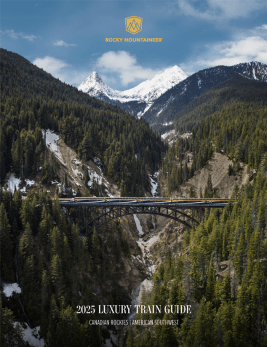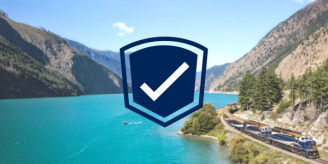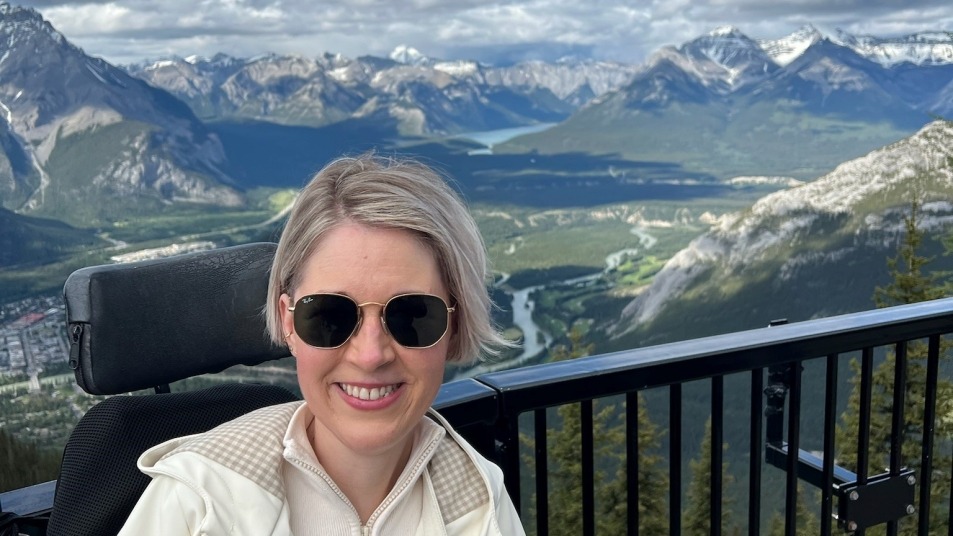
In a world where travel is often seen as a gateway to adventure, accessibility remains a critical aspect for many individuals. We had an enlightening conversation with Sarah, a passionate traveller and wheelchair user, who shares her firsthand experiences travelling onboard Rocky Mountaineer and exploring new destinations while using different forms of transportation. From the challenges she faced to the powerful moments of support, Sarah's story sheds light on the realities of accessible travel. Join us as we explore her journey, the importance of inclusivity, and gain insight into opportunities to make travel even more accessible for everyone.
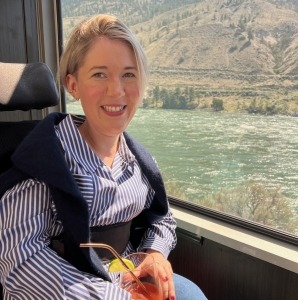
Tell us a bit about yourself.
My name is Sarah, and I live in the UK and am a wheelchair user. I love to travel – so much so that it’s also my day job. As a disabled person, travelling (at home and abroad) takes months to plan. I need to take my powered wheelchair, ventilator, hoist and shower chair with me. I also need to fund the travel of my Personal Assistant (aka caregiver) so ‘big trips’ are a major logistical and financial commitment for me.
What motivated you to book a Rocky Mountaineer journey?
It started when my family and I realised that we all had Alaska on our ‘bucket list’ and after a particularly tough year we thought “life’s too short – let’s go!” At this point, we realised that we all wanted to incorporate Canada, and remembered seeing my Aunt’s amazing photos from her Rocky Mountaineer journey a few years ago.
I work as an accessibility consultant in the transport sector. I consciously don’t own a car and love travelling by train. I think it’s such a relaxing way to travel, so we knew we were going to book this trip, provided accessibility levels were right for us.
What were some questions you had prior to booking a Rocky Mountaineer journey when thinking about accessibility?
My chief concern was getting onboard in my powered wheelchair. I can’t walk or stand at all so there’s no flexibility for transferring to a seat or lifting my chair. I found a video online that a wheelchair user had made of his experience, but I was conscious he used a manual wheelchair. Would the hydraulic lift take my chair’s 100kg weight?
Also, we were aware that Rocky Mountaineer organised the hotel and transfers to/from the train, but we wouldn’t know the identity of the precise hotel until we got there. This meant I couldn’t research specific features of the hotel’s accessible room e.g. if my hoist’s legs would fit under the bed or whether my shower chair would go over the toilet. The team were very reassuring, but I still couldn’t quite picture it. I had to take a leap of faith!
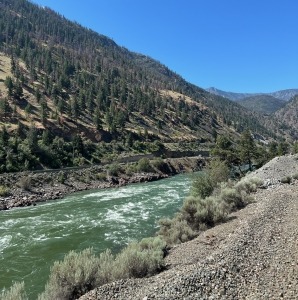
Tell us about your journey onboard Rocky Mountaineer.
We travelled on First Passage to the West, starting in Banff and ending in Vancouver. The first few hours I barely spoke to my family - we just kept glancing at each other with a look of “can you believe this?!” The snow-capped Rockies (even in July) were breathtaking. I loved winding through the rivers, lakes and tunnels and seeing the landscape change dramatically over the two days.
We were booked in SilverLeaf Service. Personally, this was ideal for us, but also for anyone with limited mobility. Imagine two days of at-seat service, with refreshments and scenery brought to you!
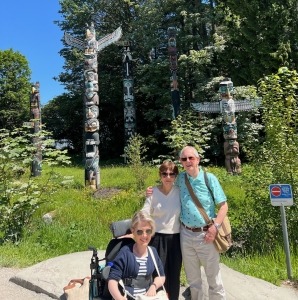
Sarah and her family visiting the Totem Poles in Stanley Park, Vancouver.
How did you find navigating around Banff and Vancouver?
After landing in Calgary, we went straight to Banff and were treated to a carnival on arrival - it was Canada Day. We took a public bus into town, which was refreshingly accessible. The next day we took a taxi to Lake Louise as none of the excursions offered accessible transport. This cost us around $345 (including an hour’s wait time) but it was worth every cent to see this extraordinary turquoise blue lake.
We were wise to book the taxi well in advance as it was the only accessible taxi in the region. It was really no surprise then to see the same vehicle and driver pick us up the next morning to take us to Rocky Mountaineer as part of our organised transfers!
We had a full day in Vancouver after our Rocky Mountaineer journey (and another one at the end of our Alaska cruise). As a transport consultant, I had to sample as many forms of public transport as I could squeeze in. We took a bus to Stanley Park, did a quick round-trip on the SeaBus and a visit to New Westminster just to use the SkyTrain. In that sense it felt like a city that is very comfortable in its accessibility offering.
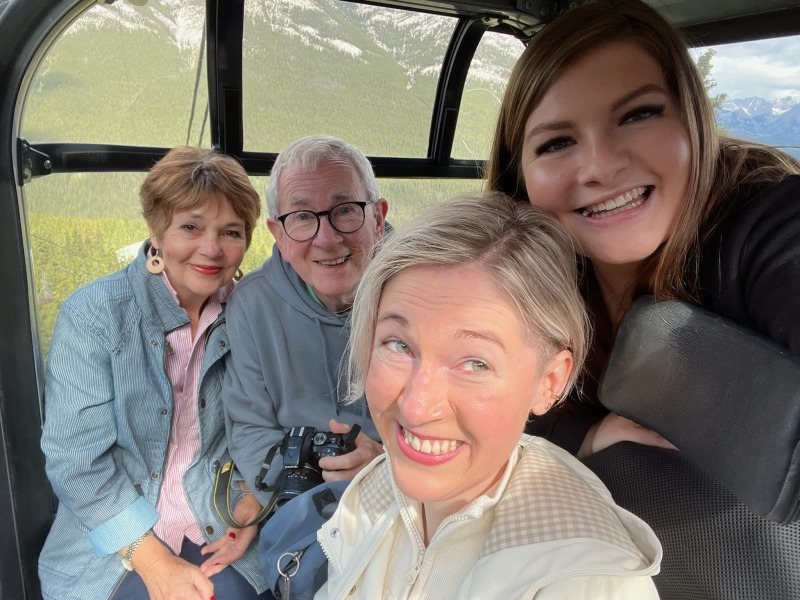
Sarah and her family on the Banff Gondola.
What are some recommendations for accessible attractions in Vancouver and Banff?
Apart from Lake Louise, the other incredible experience we had in Banff was getting the Gondola (cable car) up to the summit of Sulphur Mountain. In my wildest dreams, I never thought I’d find myself enjoying a meal and bottle of wine at 700 metres gazing at six mountain ranges.
In Vancouver, the totem poles in Stanley Park are unmissable. But I would also recommend a wander around Gastown to see the Steam Clock. Several locals kindly warned me that I may not find the historic ‘cobbles’ of the area accessible. In fact, it was perfectly fine. Perhaps because in England, ‘cobbles’ are really bad, I found this surface delightful in comparison!
What were some highlights from your journey?
Where to start? Seeing a grizzly bear 3 yards from the train…winding through the Rockies…bald eagles flying overhead…discovering Caesar cocktails… I couldn’t tell you my favourite part, but it was definitely one of the best travel experiences of my life.
If you could share one thing with someone considering a journey with us, what would it be?
My advice to prospective guests would be to fill out the accessibility form with all the key information asked – wheelchair size, battery type, etc. – and relax. It’s always a leap of faith to trust a company to make a correct judgement over whether your access needs can be met by them, but I do wish I’d relaxed more in advance. I’ve made some videos of my trip on Instagram and TikTok for other disabled people to watch as this tool can be so helpful when assessing for yourself whether you will be comfortable and not experience access barriers.
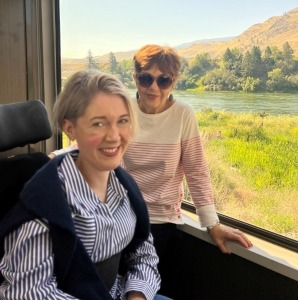
What's something prospective guests should know about accessibility onboard Rocky Mountaineer?
I think it’s probably helpful to know that a wheelchair user staying in their chair does sit alone. My family was just across the aisle in pairs of seats. At first, I was a little disappointed as I thought I might miss the company. However, I soon realised that it wasn’t like an aircraft or domestic train - everything was far more spacious and relaxed. My party would often come stand by me to get a particular view for a camera shot and we could still chat across the aisle without raising our voices. But if you do need a companion next to you or you’re on a romantic honeymoon trip you might want to consider this!
Were there any surprises or unexpected challenges along your journey?
In the afternoon of the first day, the train manager approached me discreetly to explain that the one accessible taxi in Kamloops had broken down. My heart sank. She wanted to double check her understanding that I couldn’t transfer to a seat. She told me not to worry but, of course, I did, and I started to try to think of solutions.
20 minutes later, the manager returned to give me the good news that it was all sorted: an arrangement had been made with a local care facility for them to drive us to our hotel in their accessible van. I liked that she said she wanted to tell me the news straight away so I wouldn’t be distracted for a minute longer.

Sarah and her personal assistant (and caregiver) with the disappearing straw!
Could you tell us a bit about your experience with the service you received from our Onboard Team?
The Onboard Team played a huge role in the overall experience. Dawn and Jess were our onboard hosts – they were knowledgeable, professional and had a great sense of humour. Captivating tour guides and simultaneously pouring cocktails. I was personally impressed and grateful for the way in which they observed and supported my access needs over the two days. My reusable straw kept disappearing and ‘magically’ reappearing from the staff dishwater in between drinks trolley rounds. They wouldn’t allow me to dip my straw from my morning coffee into my first cocktail of the day! Thoughtful touches like this make you feel so welcome and relaxed.
As we conclude our conversation with Sarah, we're delighted to see that her experiences show both the improvements made in accessible travel and the areas that present an opportunity for growth. Her journey onboard Rocky Mountaineer highlights the importance of creating a more inclusive travel environment. By sharing her story, Sarah not only inspires others to embark on their own adventures, but also encourages all of us to recognize and address the barriers that still exist. We are incredibly happy that Sarah and other wheelchair users have been able to enjoy journeys onboard Rocky Mountaineer. As we continue to evolve to meet our guests' accessibility needs, we remain committed to working toward a future where the joys of exploration are available to all.


